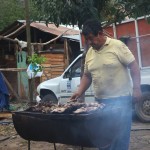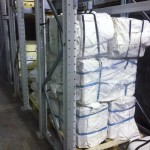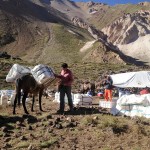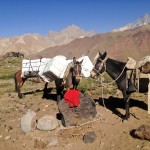Getting The Ice Cores Home: Blog Six
Click here to see all Climate Change blog entries.
We thoroughly enjoyed the time we spent in Maitenes waiting for the Arrieros to join us with the remaining equipment. We enjoyed beautiful weather and delicious meals, which always included fresh fruits and vegetables that are very difficult to maintain in the field. We spent our time assessing the equipment we had with us for possible damage.
Obviously, our tents are subjected to harsh conditions such as high velocity winds, volcanic soils and dusts, and strong UV radiation, and it is very important that we inspect each item carefully to ensure it is adequate (or not) for another field season. Although we were enjoying nice conditions, the Arrieros were not so fortunate with the weather. Up at the top of the mountain they were encountering some strong winds and snow. Luckily, they were able to get the last of the gear down in one trip and they were as happy as we were to return to Maitenes.
Once all the gear was reunited, we inspected everything and separated the essential gear (drill, tents, sleds, rope, etc.) that we were returning to Maine and insured it was all safe for travel. We gave all the remaining unused food to the Arrieros as an extra thank you for their great job. During this time, we were also communicating with Paul and Michael. They gave us a more detailed account of the ice cores’ safe transport to
Santiago and present condition (see photos). Currently, the ice cores are sheltered in a freezer in Santiago waiting to shipped by sea from Valparasio to Boston. It’s incredible to think that this ice core, which began as snowflakes hundreds, or perhaps thousands, of years ago on top of a volcano in the middle of the Andes, will now travel north into the tropics across the equator and come to rest in a laboratory in a small town in Maine. Of course, part of our job will be to determine exactly how long the ice resided in the Andes.
As we were finishing our packing the Arrieros kindly invited us to their home to enjoy a farewell assado (barbeque). The food was excellent and included grilled goat, avocadoes, and freshly baked bread. We toasted to
a successful field season and discussed potential future endeavors in the Andes. Michael reported there was no damage to any of the ice cores, which is incredible considering the terrain they were transported over. Again we would like to thank the Arrieros for an amazing job; working at high-altitudes is extremely difficult especially when handling delicate ice in the mountains.
- The arrieros put on an assado (farewell barbecue) to celebrate the end of a successful trip
- The ice cores made it safely to a freezer in Santiago, Chilé
- Mules were used to pack the ice cores down the mountain in insulated boxes or dry ice
- Mules were used to pack the ice cores down the mountain in insulated boxes or dry ice




